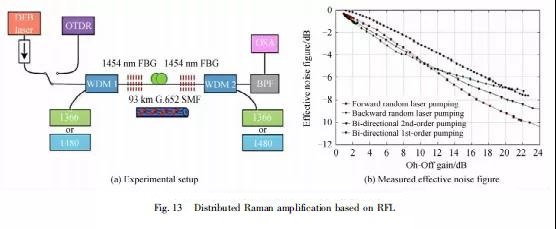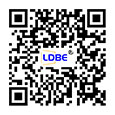Application of Fiber Random Laser in Distributed Sensing
In 2013, a new concept of DRA based on high-end DFB-RFL pump was proposed and verified by experiments. Due to the unique semi-open cavity structure of DFB-RFL, its feedback mechanism only relies on the Rayleigh scattering randomly distributed in the fiber. The spectral structure and output power of the high-order random laser produced exhibit excellent temperature insensitivity, so High-end DFB-RFL can form a very stable low-noise fully distributed pump source.The experiment shown in Figure 13(a) verifies the concept of distributed Raman amplification based on the high-order DFB-RFL, and Figure 13(b) shows the gain distribution in the transparent transmission state under different pump powers. It can be seen from comparison that bidirectional second-order pumping is the best, with a gain flatness of 2.5 dB, followed by backward second-order random laser pumping (3.8 dB), while forward random laser pumping is close to the first-order bidirectional pumping, respectively At 5.5 dB and 4.9 dB, the backward DFB-RFL pumping performance is lower average gain and gain fluctuation. At the same time, the effective noise figure of the forward DFB-RFL pump in the transparent transmission window in this experiment is 2.3 dB lower than that of the bidirectional first-order pump and 1.3 dB lower than that of the bidirectional second-order pump. Compared with the conventional DRA,this solution has obvious comprehensive advantages in suppressing relative intensity noise transfer and realizing full-range balanced transmission/sensing, and the random laser is insensitive to temperature and has good stability. Therefore, DRA based on high-end DFB-RFL can be It provides low-noise and stable distributed balanced amplification for long-distance optical fiber transmission/sensing, and has the potential to realize ultra-long-distance non-relay transmission and sensing.

Distributed Fiber Sensing (DFS), as an important branch in the field of optical fiber sensing technology, has the following outstanding advantages: The optical fiber itself is a sensor, integrating sensing and transmission; it can continuously sense the temperature of each point on the optical fiber path The spatial distribution and change information of physical parameters such as, strain, etc.; a single optical fiber can obtain up to hundreds of thousands of points of sensor information, which can form the longest distance and largest capacity sensor network at present. DFS technology has broad application prospects in the field of safety monitoring of major facilities related to the national economy and people‘s livelihood, such as power transmission cables, oil and gas pipelines, high-speed railways, bridges and tunnels. However, to realize DFS with long distance, high spatial resolution and measurement accuracy,there are still challenges such as large-scale low-precision regions caused by fiber loss, spectral broadening caused by nonlinearity, and system errors caused by non-localization.








